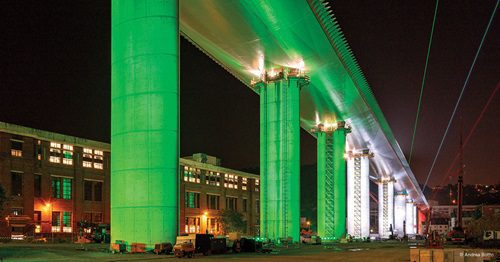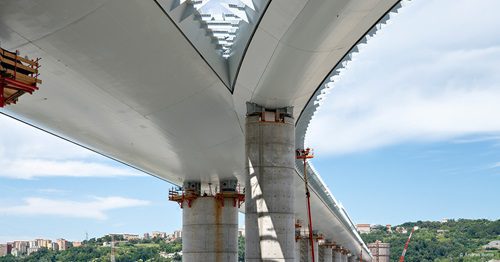Genova San Giorgio bridge: RINA at the helm of a great Italian engineering success

Constant planning and schedule adjustments, non-stop work 24 hours a day, 7 days a week and 80 technical specialists dedicated to Project Management, Works Supervision and Safety Coordination has resulted in the bridge being opened on time and on budget. The “Genoa model” is the result of total commitment and round-the-clock management and supervision.
Genoa – The Genova San Giorgio bridge reopened just 15 months from the start of construction work. Managing a project of this size and complexity relies on good planning and RINA, the Project Management Consultant for the project, was instrumental in managing both the demolition of the old Morandi bridge and the construction of the new Genova San Giorgio bridge, in an exceptionally short time.
The numbers make interesting reading, there were over 220,000 hours of engineering work generating more than 3,200 technical documents and reviewing over 1,500 project sheets. A team of 80 RINA specialists was dedicated to managing the project guiding the construction phases, timelines, budgets and progress of the work. There were 20 sites operating simultaneously, 7 days a week, 24 hours a day without interruption for almost two years, apart from Christmas Day in 2019.

RINA’s oversight across the entire project included responsibility for Works Supervision and Safety Coordination plus Quality Assurance during both the demolition and construction phases. Now, following the official inauguration of the new bridge, work will continue over the coming months to complete the restoration of the site areas below the bridge.
“It seems incredible to think that just 596 days have passed since the start of activities and today we can at last pause to celebrate a project of reconstruction in the heart of Genoa,” said Ugo Salerno, President and CEO of RINA. “It all began with a tragic event that we will never forget. But now is the time to build on the positive energy that has been created and look to the future. The “Genoa Model” has already become well known and some say that it is not replicable in other projects, but I don’t think that’s true. Rapid construction is not a question of skipping procedural steps or paying less attention, but rather of planning each and every activity in detail to overcome the inevitable unforeseen events and get immediate and effective responses from all those involved, in particular from the public authorities. More broadly I believe that the restart of our country also depends on this: commitment and dedication combined with a public administration that does not hold back work.”
“Although I love the term, it is not the ‘bridge of miracles’, but the result of excellent teamwork across all the stakeholders, with RINA playing a key coordinating and supervisory role,” explains Roberto Carpaneto, CEO of RINA Consulting. “The Project Manager is a concept that you can find all over the world, particularly in complex infrastructure projects. In Italy it is not so common. This lack of precise planning and optimal management of each step, from start to finish often results in projects being late and over budget. When rebuilding the Genoa bridge, natural disasters such as the floods in November 2019 and the Covid-19 pandemic required dynamic adjustments to the planning. RINA introduced physical protection, training and tracing, something that was started prior to the Italian government’s decision, but these steps did not lead to delays in completing the work. Managing some of the environmental challenges especially during the demolition which included reducing dust levels and preventing the threat of asbestos contamination were difficult but where achieved. I also want to thank the citizens of Genoa for the warmth and sympathy with which they have always supported our efforts.”
As Project Management Consultants working directly for the Extraordinary Commissioner, RINA ‘bridged’ the gap between all stakeholders involved in the project. This role was necessary to ensure that all project requirements were delivered on time and on budget while liaising with all the construction companies and the people of Genoa. The design of the bridge has been termed as a ‘statement in its understatement’ accentuating the beautiful valley between mountain and sea and it will be truly environmentally friendly by including photovoltaic panels for energy, water treatment processes, and ongoing structural monitoring, that will ensure ongoing sustainability and safety. The importance of the bridge to the Genoese should not be underestimated together with the memory of those that lost their lives during the collapse of the original bridge.
RINA provides a wide range of services across the Energy, Marine, Certification, Transport & Infrastructure and Industry sectors. With net revenues of EUR 476 million in 2019, a global network of over 3,900 talented professionals and 200 offices in 70 countries around the world, RINA participates in major international organisations and has contributed consistently to the development of new regulatory standards. www.RINA.org
Facts & Figures and Infographic: https://www.rina.org/en/media/press-hub
Drone video footage of demolition and construction phases: https://www.rina.org/en/media/press-hub/video-drone
Time lapse video of entire project: To Watch or to To Download
Video Statements: https://www.rina.org/en/media/press-hub/video-statements
Project Timeline:
- 14 August 2018: Collapse of the Morandi Bridge.
- 15 November 2018: The Senate passes the Genoa Decree Law.
- 14 December 2018: The Mayor of Genoa and Extraordinary Commissioner for the Reconstruction, Marco Bucci, awards the contract for the demolition of the remains of the Morandi Bridge.
- 15 December 2018: The President of the Liguria Region, Giovanni Toti, and the Mayor of Genoa and Extraordinary Commissioner, Marco Bucci, officially open the construction sites for the demolition of the remains of the Morandi Bridge.
- 9 February 2019: Demolition of the Morandi Bridge begins.
- 15 March 2019: One of the last decks on the West side of the former viaduct is “lowered”. In the following months the structure will be completely demolished.
- 15 April 2019: Reconstruction officially begins with the placing of the first pile.
- 1 October 2019: The first deck is laid between pile 5 and pile 6.
- 25 June 2019: The first stone is laid with the casting of the base of pile 9 of the new “Ponte per Genova”, designed by architect Renzo Piano.
- 28 June 2019: The last remaining structure of the Morandi Bridge, piles 10 and 11, are demolished in a controlled explosion.
- February 2020: The first maxi beam of the new bridge over the Polcevera river is hoisted into place.
- 27 April 2020: The positioning of the last section of the new viaduct that begin.
- 28 April 2020: The last section of the viaduct is put in place; RINA looks at the complete deck of the new San Giorgio Viaduct.
- Beginning of August: Opening of the new San Giorgio Viaduct


